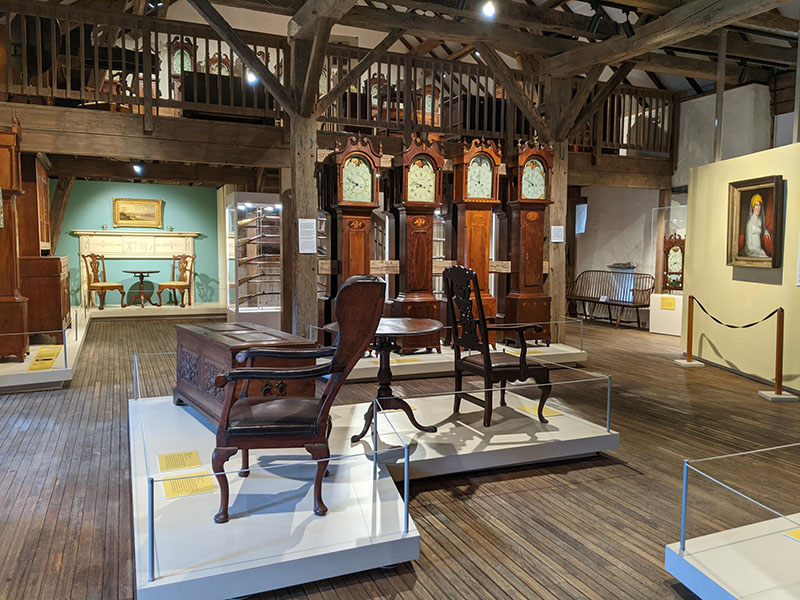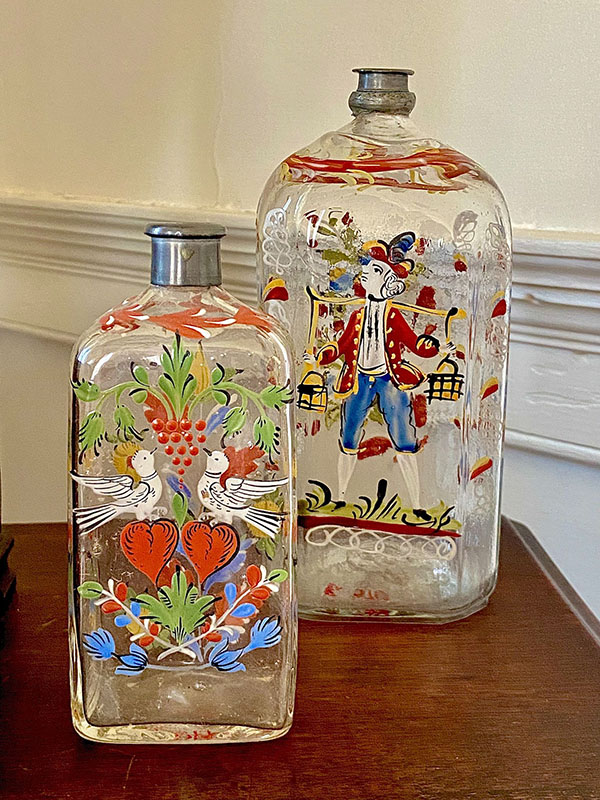Completing the Picture: New Research into Craft, Slavery, and Servitude in Early Lancaster
Click on images to enlarge them and view captions.
by Bethany McGlyn
In 2021, the Decorative Arts Trust awarded Historic Rock Ford a Dean F. Failey Grant to support “Completing the Picture: Slavery and Servitude in Early Lancaster County.” This initiative seeks to research and reinterpret objects and spaces at Historic Rock Ford and the John J. Snyder Jr. Gallery of Early Lancaster Decorative Arts in order to more fully explore the complex histories of those who made and used them. Historic Rock Ford was the home of Edward Hand, Adjutant General to George Washington during the Revolutionary War, his family, and enslaved and free servants and laborers. Today, Historic Rock Ford comprises 33 acres surrounded by Lancaster County Park and offers guided tours of the 1794 Hand Mansion as well as the newly opened Snyder Gallery, which showcases decorative arts primarily from Lancaster County dating from the era of the Hand family’s residence in Lancaster (figure 1).
Although our research has identified enslaved persons, indentured servants, and prisoners of war who worked as artisans and tradespeople in early Lancaster—including cabinetmakers, painter glaziers, shoemakers, carpenters, coopers, spinners, and more—the dominance of the iron industry in the region has provided a breadth of primary source documentation (figure 2).
Business and financial records, correspondence, and runaway advertisements all point to the widespread use of bound labor in Southeastern Pennsylvania’s iron industry in the 18th and early 19th centuries. Runaway advertisements and Sheriff’s notices placed in the Pennsylvania Gazette name several enslaved and indentured (including apprentices and convict servants) colliers, blacksmiths, joiners, chimney sweeps, and hammermen. English servants Charles Smith and Thomas May, Irish servants Richard Tobine and Thomas Doyl, and Scottish convict servant Daniel Meansey labored at the Grubb ironworks sites at Cornwall and Hopewell. In 1772, Curtis Grubb advertised for the return of an enslaved man named Jack, who self-liberated from Cornwall Furnace wearing “an iron collar about his neck.”1 Runaway advertisements like this one show that unfree laborers and artisans in Lancaster County, whether enslaved or indentured, were often recorded wearing iron collars—to identify and punish those at risk of absconding—that were likely made at Southeastern Pennsylvania’s ironworks. Cuff Dix, a hammerman enslaved at Birdsboro Forge in present day Berks County, PA, claimed his freedom while wearing an “iron collar round his neck,” although his enslaver, Mark Bird, assumed “he will soon get that off.”2 Andrew Marwood, an English servant indentured to Lancaster resident James Davison, “had leg irons on, and an iron collar on his neck” when committed to the Chester County Jail in 1776.3 Irish servants John Hanley, Francis McNealis, and Edward Loller, and enslaved men Jack, Will, and Pero all appear in the Pennsylvania Gazette as runaways from Lancaster wearing iron collars.4
The Lancaster County iron plantation Elizabeth Furnace further illuminates Lancaster’s role in a larger Atlantic world that was deeply entangled—both socially and economically—with slavery in locations as far away as the Caribbean. Henry William Stiegel, who purchased Elizabeth Furnace in 1757 before assuming his better-known role as founder of the American Flint Glass Manufactory in present-day Manheim, advertised “sugar house stoves, with cast funnels of any height for refining sugars, weights of all sizes, grate bars and other castings” specifically for “sugar works in the West Indies” (figure 3).5 Archaeologists at Millersville University conducted excavations at Elizabeth Furnace from 2005–07, and their extensive research on the site and its Atlantic connections revealed that both iron and glass objects from Stiegel’s tenure at Elizabeth Furnace were identified amongst the ruins of a shipwreck off the coast of Bermuda (figure 4).6
Robert Coleman, who previously worked with the Grubbs at Hopewell and Cornwall, assumed management of Elizabeth Furnace in 1776 and capitalized on the Continental Army’s urgent need for munitions. Following the Battle of Trenton in December of 1776, Edward Hand and George Washington negotiated payment from Congress to Coleman for 70 Hessian prisoners of war to work at Elizabeth Furnace.7 Reliance on bound labor at Elizabeth Furnace and in Coleman’s own household (where no less than seven enslaved men, women, and children named Bet, Jane, Anthony, Charles, Nan, Lony, and Juba lived) contributed to Elizabeth Furnace’s staggering success and Robert Coleman’s title as Pennsylvania’s first millionaire.8
Historic Rock Ford is grateful for the Decorative Arts Trust’s support for this research, and we look forward to welcoming visitors to the Edward Hand Mansion and John J. Snyder Jr. Gallery of Early Lancaster Decorative Arts this season.
- Pennsylvania Gazette, November 4, 1772.
- Pennsylvania Gazette, May 24, 1775.
- Pennsylvania Gazette, May 4, 1776.
- Pennsylvania Gazette, February 2, 1743; March 10, 1747; December 20, 1753; June 20, 1755; September 6, 1764; September 13, 1764; July 21, 1768; April 25, 1771; April 28, 1773; May 8, 1775.
- Pennsylvania Gazette, March 3, 1769.
- Timothy D. Trussel, “Pennsylvania Iron and Bermuda Sloops: How Bermuda Merchant Captains Connected an 18th Century Pennsylvania Iron Plantation to the Atlantic World,” Bermuda Journal of Archaeology and Maritime History 17, (2006): 164–184.
- Pennsylvania Colonial Records, X, page 662, and “Lancaster Borough: Home to British and Hessian Prisoners of War, 1775–1784,” in Journal of the Lancaster County Historical Society 89, no. 4 (1985): 144–151.
- “Register of Negroe & mulatto slaves & servants,” 1780, 3, Lancaster History Library.
Bethany McGlyn is a guest curator at Historic Rock Ford and the John J. Snyder Gallery of Early Lancaster Decorative Arts. She is a PhD candidate and Jefferson Scholars Foundation Fellow in the Corcoran Department of History at the University of Virginia.
A print version of this article was published in The Magazine of the Decorative Arts Trust, one of our most popular member benefits. Join today!




